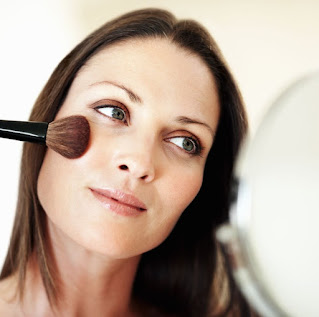Who knew a makeup brush could turn back time!
If your makeup products were your children (I mean, aren't they?), your foundation would be the problem child. It's almost like your foundation likes to cause issues — one day it's too dark for your skin tone, and the next day it looks more layered than a wedding cake. You're left wondering: Why does it seem like every other woman on my Instagram feed gets it right? Maybe, just maybe, it's because they've already read this article.
We're not going to waste any time with how to choose the right foundation (get that here), or how to choose the best foundation brush (pop over here), or how to use a Beautyblender (that's here!). Right now, we're going to be laser-focused on how to apply foundation so that it looks natural — you know, that glowy, stress-free, seven-years-younger look that we're all low-key getting after.
How to Apply Tinted Moisturizer
Apply a lightweight, sheer formula like tinted moisturizer, BB cream, or CC cream "as you would a moisturizer," smoothing on with your fingers and hands," says Maybelline New York global makeup artist Grace Lee. As for how much? "Use a pea- to dime-size amount," adds Ashley Gray, a professional makeup artist and founder of Ashthetics Skincare.
How to Apply Liquid and Cream Foundation
For liquids, which are thinner, use a dense-bristled foundation brush to spread the product (again, Gray suggests a dime-size amount) over large areas and blend it into the creases. A makeup sponge, like the Beautyblender, better distributes thicker creams and can stipple it on smaller spots. But using a makeup applicator may absorb some of the product, so Gray recommends adding more if you still need more coverage.
How to Apply Loose and Pressed Powder Foundation
Buff either kind of powder formula onto skin with a loose-bristled powder brush, using circular motions to diffuse the pigment evenly for the most natural finish.
How to Apply Concealer
Our makeup experts agree that concealer should be applied after foundation — and just like your foundation, your concealer should blend right in with your skin tone. “Target around the nose, under eyes, the middle of the chin and forehead, inner eye sockets, and any discolored areas,” says Birgitte Philippides, a makeup artist and image — and tap, don’t spread, for maximum coverage.
Now that we've covered how to apply foundation, let's talk about how not to apply foundation. Just avoid these common mistakes:
1. Don't skip the primer.
When you're in a hurry, it can be tempting to bypass a few steps in your morning routine. But keep primer in the lineup, as it's key to a smooth, long-lasting finish. A silicone-based makeup primer like GH Seal holder CoverGirl Simply Ageless Anti-Aging Foundation Primer ($15, ulta.com) is an excellent choice.
2. Don't apply foundation right after moisturizing.
Always give your moisturizer time (as long as 15 minutes) to absorb into your skin before applying foundation. Otherwise, you can end up with a streaky mess.
3. Don't go overboard on product.
Achieving an even complexion is the goal, but overloading your face with layer after layer of foundation is a one-way ticket to Cakey City. If you're dealing a monster pimple, here's a quick tutorial on covering up blemishes.
4. Don't forget your neck!
Because your neck tends to be lighter in tone than your face, blend your foundation beyond your jawline for a natural, seamless finish.

